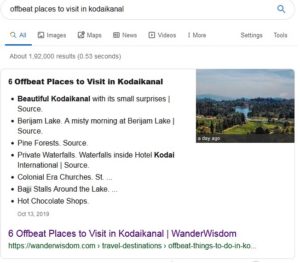
When learning Search Engine Optimization, people come across a repetitive array of techniques – keyword search, optimizing meta-titles and descriptions, mastering back-links, and in fact, even images. Yet a key aspect like featured snippets remain in the dark irrespective of its effectiveness, some talk about it but is never truly mentioned in-depth.
SEO terminology can be hefty to get into, but featured snippets are something all of us come across daily. To master features snippets is to master position-O, the Google’s Answer Box.
What really are featured snippets?

Featured snippets are specific answers to specific search results on search engine platforms like a google. Based on its algorithm, Google finds the best possible answer to a search across a storehouse of websites. It then displays the particular part of a webpage, a short summary that caters to a question along with the URL and the title of the blogpost/article.
It is evident that featured snippets drive the most traffic being displayed at the very beginning of search results with the most detailed glimpse of the contents of a webpage. There are primarily four types of featured snippets: A textual paragraph, a numbered/bulleted list, a table or a YouTube video. Most of these snippets accurately answer a search question and can often restrict further enquiry on a search engine.
The range and reach of featured snippets are high – most (as high as 85 percent!) result in voice answers to voice research features. There are options to refine an answer when looking for it in a feature snippet – allowing viewers to have better insight into a website. To be featured in a snippet, one should also expect to have mastered other forms of SEO, for most of these come from pages that are already high ranked and displayed on the first page of the search engine. AA characteristic trait is the use of longtail keywords with a monthly search volume of less than 100, which trigger a snippet.
The Optimization Process
A few targeted strategies focusing solely on featured snippets can boost SEO drastically. Some of these strategies include:
- Using Questions: Targeted keywords when put together with questions can be very effective in directing snippets. Making use of “what”, “how” and “why” return a snippet about 90% of the time and have a bashing 480% increase in the percentage of keywords in featured snippets.
- Length: The ideal length when aiming at this part of SEO is to stick to anywhere around 40-50 words in case of paragraph snippets. It conveniently answers the question of a user as well as is an effective gist of content to be displayed, rather than something that has been cut-off mid-way.
- Long Lists: Not only lists, but tables also, containing more than 8 points often get telescoped to display only the first few – while hidden content is paragraphs may damage user experience, partially hidden lists lure readers into your webpage. The “More items…” icon makes the reader curious and look for more to continue his/her search.
- Visuals: A SEMRush study revealed that most featured snippets used more than 12 images, optimized with appropriate alt text and titles. Not only do they improve SEO, but are appealing to the eye, as well as infographics can make content easier to understand and summarize. A template to follow is images in landscape mode with an aspect ratio of 4:3, but is not a hard and fast rule.
- HTTPS: Most websites have been using an http in their domain, and was considered something only ecommerce websites should worry about. Until recently, when Google revealed that using https instead of http ranks higher in search, every blogger is making the transition to https. Similarly, 83% of all the sites that show up in featured snippets also use an https.
- Mobile Usability: A mobile-friendly interface is an integral part of every SEO technique, and so is it for featured snippets. It is an inevitable must-have, where the website must score a minimum of 95 on “Google Mobile Friendly” and “Google Mobile Usability” tests.
- Link Juice: All SEO practitioners make use of links to drive traffic and seem more reliable, but a good idea is to not hoard it. Pages that are featured in multiple queries generally have 30-40 outgoing link citations in that particular piece of content.
- Readability: Content is king, again! Until and unless a piece of word is conveniently understood by users, it cannot rise up in rankings to make it to a featured snippet. A page’s readability can be tested on the Hemingway Editor, and should at the least have a Flesch-Kincaid readability of 7th grade or less, i.e. 70/100.
- Domain Authority: Earning links from trusted websites in the chosen niche, being genuine and increasing site authority are all incredibly vital parts of SEO and being featured.
- Schema Markup: A schema markup is a form of microdata to help search engines. The recommended schema markup by Google is JSON-LD, implementing which makes its job easier by explicitly indicating ratings, headlines and descriptions. There are also a lot of plugins that help applying this feature.
- Consistency: All high-ranked websites have one thing in common – all of them are incredibly active. Being consistent in posting, even if it’s an e-commerce store with a blog, gains viewership and feeds SEO. Loading a website with tangible and relevant information answers questions being asked on search engines and are consequentially featured in snippets.
–
- Heading Tags: H1-H6 tags do not only serve featured snippets, but across all SEO goals. Structuring a webpage into proper headings and sub-headings clarifies the hierarchy of an article, enhancing ease of reading and is sensed by algorithms.
- HTML: Semantic HTML, if implemented correctly, clarifies this structure to Googlebot or its algorithm. The Googlebot is then enabled to understand the structure of a website, provide more accurate search results, cater to your niche and to focus on the main content of your page while answering questions on the search box instead of navigational and subsidiary elements and meta information.
- Social Shares: Responsiveness is one of the most important ranking pre-requisites. The amount of interaction on a piece of content by its viewers and on-page engagement such as comments are directly co-related to featured snippets.
ADVANCED TOOLS – SEMRush
Outside basic optimization, especially targeting featured snippets can also include a range of well-researched and slightly time-consuming but more effective methods of SEO.
- Filtering Keywords: A well-laid down research is never a waste of time. One of the most well-known tools to serve this purpose is SEMRush’s Organic Research Tool. Getting a list of keywords for the desired rank but are not being featured in snippets. Searching for specific keywords targeting featured snippets can be incredibly helpful.
- Hijacking: The Organic Research Domain also allows feeding into a competitor’s domain including only ‘Featured Snippets’ in an SERP features. This list can then be exported and compared via Keyword Gap Tool to get an insight into its faring in the SERP
- Seed Keywords: Keyword search is mastered by many SEO experts and learners. An elaborate list of rank tracking and SERP scraping tools are used to prepare an extensive list of primary and secondary keywords. However, how do you master seed keyword – the word you should look for to seek its ranking? The Topic Research tool helps find search terms and longtail keywords pertaining to a particular and look into user patterns and trends.
- Tracking: As much as research and knowledge is important, so is keeping track. Tracking chosen keywords can be done by The Position Tracking tool which would track data based on featured snippets. This includes opportunities, already featured, new and lost keywords along with an estimated traffic potential.
